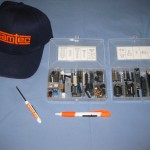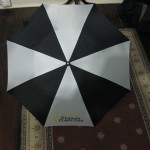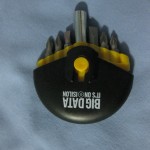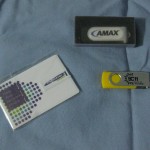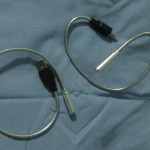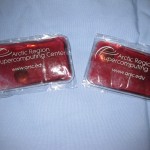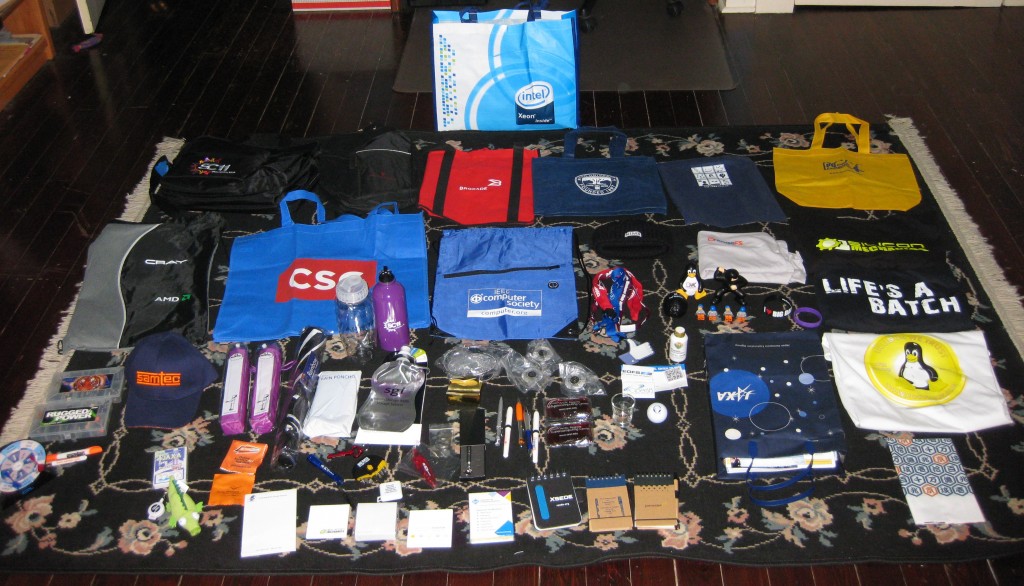
This is the less serious bit of review from SC’11, but there is fun to be had and a certain amount to be learned from the pile of schwag that comes back. The schwag pile is comparable to last year’s, but I was actively aimed toward useful or at least interesting junk this year, since I have > three cubic feet of this crap packed away now. Part of the point of this post is just to give credit (and links) to places that gave me cool stuff.
I find I actually use the various random bags I get, so I always end up with quite a few. Several were particularly nice: For the second year in a row, I would actually USE the conference bag (Back left corner) on it’s own, and I got another one of the ridiculously tough Tyan/Intel bags (far back, standing) which are handy for groceries and toting stuff around campus. Indiana University had a nifty little sling bag that I could contrive uses for (next to conference bag), and the giant blue CSC bag can consolidate a remarkably large pile of crap.
With regard to apparel, Silicon Mechanics again had the nice florescent green on black logo tee that I wear all the time, although this year’s has some text on the back that makes it a little less cool. We hung out for a while talking to the Pogo Linux folks and were handed a pile of their shirts (logo on front, gold circle around Tux on back, back visible in picture), which are pretty nice. The Adaptive Computing/MOAB “Lifes a Batch” shirt is clever in the same way the Platform Computing “Whatever” shirt from a few years ago – I don’t know that it will get worn much, but it’s a memorable marketing effort (and, by the way, Moab has become really impressive – it can do PVM type tricks that PVM can’t, and look good doing it). NIMS (I’m slightly embarrassed to say I don’t remember which relevant organization with that acronym it was) had nice Beanies which may see some use this winter. I have some fuschia compact umbrellas from the conference daily giveaway (I think IBM payed for/logo’d them) to be given as gifts – we brought back one or two each… plus a box of a dozen after they stuck the remainders out.
Going through the gallery of other neat stuff in order of a appearance:
- Huge props to Samtec. I don’t recall seeing them at SC in previous years, but as an interconnect hardware vendor, it’s an entirely reasonable place for them to be. In addition to the fairly nice hat/pen/screwdriver schwag items and interesting to chat with booth staff, they were giving out trays of sample parts. I picked up the “Sample Solution” and “Rugged Power” kits, since those are the kinds of connector I use most, but the adviser picked up a full set to keep on file for helping students doing projects pick parts. Looking through them I wish I had picked up one of the R/F component boxes, because it had a gorgeous assortment of $Random_antenna_connector to SMC pigtails in it. I think I’ll be preferentially ordering/recommending connectors from them for a while.
- Penguin Computing was dispensing nice umbrellas in addition to their standard “Sit through our talk for a 6″ Stuffed penguin” routine. I talked management tools with a rep for a while, but didn’t attend the talk this year.
- Several places had nice small papergoods. I consume little notebooks and packs of post-its and tape flags pretty regularly, and can’t remember the last time I paid for them.
- Isilon had a nice little screwdriver pod thing. There can never be enough multitools.
- HP was handing out a … dorky green thing. It’s cute, and charming, and its belly is a lint-free screen cleaner, but I can’t figure out what the hell it is (alligator?). I think the confusing object is representative of their confusing business decisions of late – they had a carnival tricks theme going in their booth which also fits circus grade management.
- AMAX and Extreme Networks gave me flash drives, in addition to the proceedings drive (which is 2Gb and looks like a Kingston like the last two years, but the USBID says knockoff). Apparenlty I missed some even nicer flash drives from other places that group mates found. Flash drives are always useful and appreciated.
- The NNSA ASC booth was shoveling Flexible USB Lights out of their booth the last day, and I took a couple. I’m not sure what I’d use them for, but they appear to be identical to this $10 thing at Thinkgeek, so there’s that.
- The Arctic Region Supercomputing Center booth was not very well staffed, but they had their usual reusable chemical hand warmers, which is a great gimmick.
The “trick-or-treating for grownups” vibe of going schwagging on the floor is a bizarre joy of supercomputing, and, in addition to the standard “memorable schwag makes you memorable” marketing function, actually provides an important mechanism for striking up conversations and encouraging attendees to make good coverage of the exhibit floor. I have a not inconsiderable list of organizations who have bought good vibes with a few cent trinket, and I am the sort of person who gets solicited for tech and academia advice, so the trinkets are doing their job.

